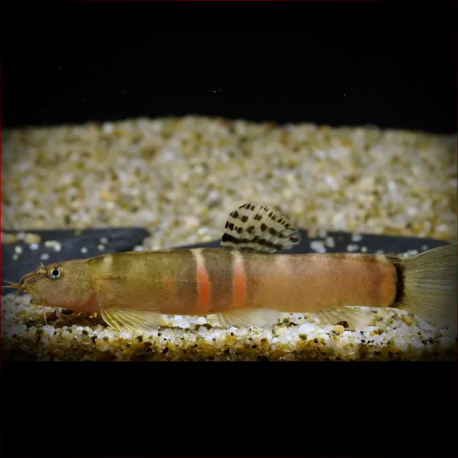More info
Datasheet
| Minimum Tank Size | 80 litres / 21.13 US gallons |
| Maximum Size | 8.0cm / 3.15inches |
| Temperature | 22°C / 71.60°F - 26°C / 78.80°F |
| Hardness | 2.02dgH / 36ppm - 12.05dgH / 215ppm |
| pH | 6.5-7.5 |
General Description
The Schistura cf. balteata, commonly known as Sumo Loach II, is an apparently undescribed species within the Nemacheilidae family. It has a variable color pattern, with specimens displaying bright pink or yellow in the posterior body half. The species has unique diagnostic features such as dark vertical bars below the dorsal-fin and round spots on the dorsal surface. Mature individuals can reach up to 8.0 cm in size, with males exhibiting enlarged cheeks compared to females.
Aquarium Setup
Schistura species thrive in tanks mimicking flowing streams, with substrates of rocks, sand, gravel, and boulders. The setup can include driftwood to form sheltered spots, providing broken lines of sight. Hardy aquatic plants like Microsorum and Anubias can be attached to decor, and the inclusion of caves is essential for individual territories. It's advisable to maintain high oxygen levels and mild water movement through power filters or airstones. Regular water changes of 30-50% are necessary due to the species' intolerance to organic pollutants.
Behaviour
Considered not highly aggressive but unsuitable for general community tanks due to specific requirements, Schistura loaches must be housed with compatible tankmates. They may show territorial behavior, especially towards similar-looking species, making a structured environment crucial to minimize aggression. While not gregarious, they can be kept in groups if the tank provides ample hiding spots and clear lines of sight to reduce confrontations.
Feeding and Diet
Schistura species are omnivorous, mainly consuming small insects, worms, and crustaceans in the wild. In captivity, they should be offered a varied diet including live and frozen foods like Daphnia, Artemia, and bloodworms. While they can accept dried foods, a diet rich in live or frozen fare ensures optimal coloration and health, especially in setups with flowing water.
Reproduction & Dimorphism
Wild-caught Schistura species like S. cf. balteata are not commercially bred, with breeding behaviors observed in home aquariums involving cave digging. Differentiating sexes is easier in mature individuals, with males exhibiting enlarged cheeks and females having a thicker body, especially when gravid. Successful breeding documentation is limited, with few reports of fry retrieval from external filters.
Habitat and Distribution
Schistura cf. balteata is found in the Ataran River drainage in Myanmar and the Kasat River in western Thailand. Its habitat comprises fast-flowing, well-oxygenated waters with substrates of sand, gravel, and rocks. The species thrives in shaded areas with minimal aquatic plants, often in high-gradient streams or cascades. It also survives in stagnant pools during dry seasons, showcasing adaptability to varying environmental conditions.

